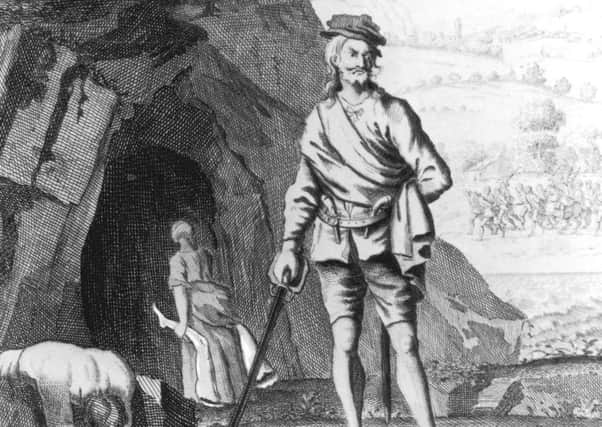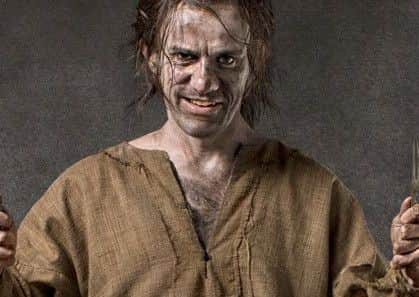Sawney Bean and his family of gruesome Scottish cannibals


After all you may well have been lulled to sleep by the retelling of the real-life chiller of Sawney Bean and his monstrous brood.
As the story goes, there was once a young idler who went by the name of Sawney Bean. This 18th century ruffian ran away from home having decided that his father’s profession of hedger and ditcher was altogether too much like hard work.
Advertisement
Hide AdAdvertisement
Hide AdBean found himself a woman as corrupt as himself and they made their home in a cave near Ballantrae on the Ayrshire coast, thus saving themselves rent money.


They fed themselves by living off the land. Lest images of wheat, turnips, fish and rabbits come to mind. Disabuse yourself of that notion. Old tales claim the means by which the Bean’s sustained themselves was by robbing any man, woman or child unlucky enough to cross their paths.
Robbing them first of their possessions, then of their lives and finally of their dignity. Once dead, the Beans removed the corpses to their lair and chopped them up. They satiated their immediate hunger before prudently pickling some leftovers for when times were lean.
The years passed and the family grew. The eight sons and six daughters needed feeding so they continued in their barbarous practices, hunting in a pack to ensure that their quarry could not escape. One estimate puts the amount that the family killed at around 1,000 souls.
Eventually the local populace noticed the alarming loss of neighbours and friends and set about hunting down the miscreants. They never found the cave, and the disappearances continued.
One day a man and his wife were riding home together from a fair, the story goes. They fell into an ambush. The wife was pulled screaming from the horse. The man could only watch helplessly as the Beans cut her throat, ripped open her belly and began to feast on her entrails. Luckily for the man (but sadly too late for his wife) just as he feared himself next, a group of 30 people came upon them and Sawney Bean and his clan scarpered.
When his rescuers heard his shocking tale they set off at a great pace for Glasgow to inform the magistrate and gather together a search party.
Large was the crowd that gathered on the coast that day, but hours of searching failed to find the hideout. Spirits were low and defeat seemed certain until a clamouring from the bloodhounds drew them to the mouth of a cave. They looked inside, but saw nothing in the gloom. The dogs though set about yowling alarmingly and would not be comforted. The men went in, their torches flickering in the half-light. They followed the twists and turns of the cave, descending deeper and deeper underground until at last they arrived at the lair of Sawney Bean. All around them, on rocks, on walls, in piles and hanging from the ceiling they saw limbs and arms, and thighs and feet.
Advertisement
Hide AdAdvertisement
Hide AdThe body parts of hundreds of people hung up in rows like a butcher’s shop. They saw bits and pieces in pickle, clothes, gold, watches and shoes. And there too they saw the grinning madness glinting from the eyes of the Bean Clan. The family was arrested. Sawney’s brood had been added to incestuously and now numbered an extra 18 grandsons and 14 granddaughters.
They were taken to the Tolbooth in Edinburgh and - without the bother of a trial - the males had their feet and hands amputated and left to bleed to death. The women watched their men die before they were put to death by the torch, burning slowly in the evening light, unrepentant and screaming abuse. And that is the story of Sawney Bean. Author Alan Brown on ‘bikepacking’ his way across Scotland Or at least it was.
From the 19th century doubts have been expressed about the validity of the tale. The story of Sawney Bean first appeared in print in the latter part of the 18th century in English newspapers at a time when England was desperate to demonise the Scots in the wake of the Jacobite rebellions. A number of attempts to verify the story have proved unsuccessful and have led to the conclusion that it is pure fabrication. Surely, the reasoning goes, such a heinous episode would be recorded somewhere?
Why is there no written documentation detailing deaths and the subsequent manhunt? How better to vilify a people than to put out this gruesome horror story of mass murder and cannibalism? What a perfect way to represent Scotland’s barbarism and the contrasting civilisation of the English. Sawney Bean is nothing more than an English invention and the scare mongering of mothers.
And that is the true story of Sawney Bean.
